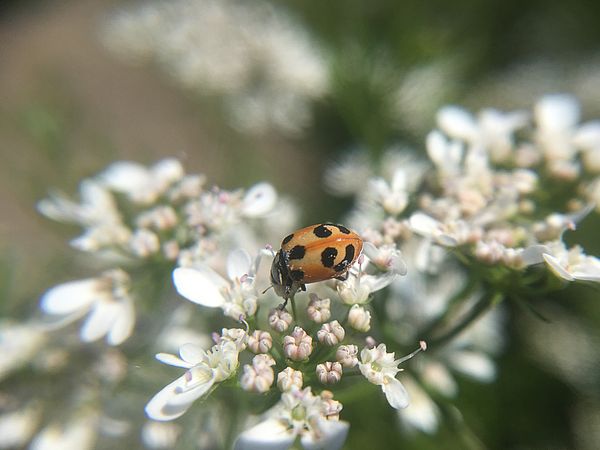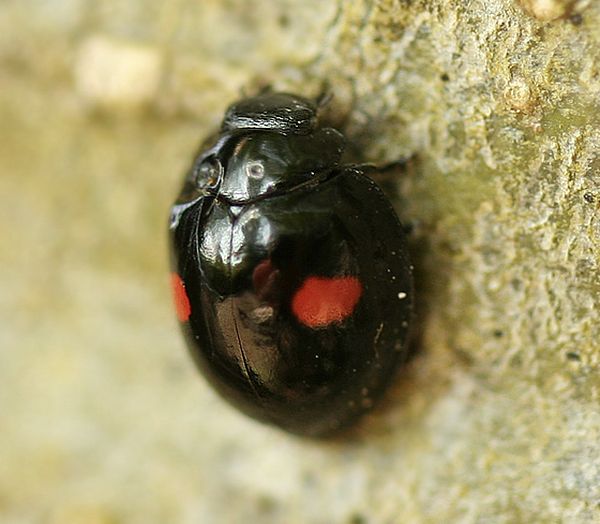Ask around and you may find it hard to locate anyone who does not like lady beetles. Even the most insect-averse among us often find themselves captivated by these multicolored beetles’ stunning patterns. They have also captured the attention of the Vermont Center for Ecostudies’ Vermont Atlas of Life team. This May, the team launched the Vermont Lady Beetle Atlas, a project focused on rediscovering Vermont’s long-lost lady beetle species.
Lady beetles were not on VCE conservation biologist Kent McFarland’s radar when he asked VCE’s software developer, Jason Loomis, to digitize a historic Vermont Lady Beetle report.
“We're always on the lookout for historic natural history data,” explains McFarland. “When we find them, our mission is to rescue them from potential oblivion in the dustbin of history. We had a 43-year-old document which provided a snapshot of lady beetle life prior to 1976—Lady Beetles: A Checklist of the Coccinellidae of Vermont. Jason began pulling the records into a database, and we quickly realized that many of the beetles reported hadn’t been seen in decades.”
This immediately raised a red flag for McFarland. He went to work, sifting through historic lady beetle collections from the University of Vermont Zadock Thompson Natural History Collection, Middlebury College, and the Vermont Forest, Parks, and Recreation collection, as well as modern records from the Vermont Atlas of Life iNaturalist project and the Lost Ladybug Project at Cornell University. As he combed through these records, a picture of Vermont’s lady beetle populations began to emerge.
In total, 40 lady beetle species have been recorded in Vermont. Seven of these species are introduced, including the Asian Lady Beetle that often joins us indoors during the winter. More concerning, 13 of Vermont’s 33 native lady beetle species have been missing since the 1970s. While it is still unclear exactly why these species have disappeared, some scientists think that either the introduced species, land use changes, or both are responsible.
Lady beetles give us more than colorful additions to Vermont’s biodiversity portfolio—they are also important predators. A friend to farmers and gardeners alike, these tiny insects feed primarily on aphids and other pests that destroy crops. Healthy, diverse lady beetle populations keep these pests in check, making the decline and disappearance of some native species quite concerning. Agriculture and managed forests in particular may get hit relatively hard when lady beetle diversity declines. Scientists currently lack a clear picture of how local declines or extirpations may affect agroecosystem stability in the era of climate change; however, they could amplify other negative impacts that already threaten many farms.
The Vermont Lady Beetle Atlas was created to find answers to the questions regarding these missing species’ whereabouts. The Atlas’s main objective is to collect information about Vermont’s lady beetle species by conducting field surveys and revisiting older records in order to develop a deeper understanding of how they are faring. However, VCE cannot undertake this endeavor alone.
Lady beetles are tiny needles in the vast haystack of Vermont’s woods, fields, and gardens, making it difficult for a handful of biologists to successfully search alone. At this time, there is little information available regarding the lady beetle species found in the Cold Hollow region. That’s why we need your help! Join us as we pursue these brilliant insects and help us better understand which species live in your area. All you need is a camera, an iNaturalist account, and curiosity. The goal is to find as many lady beetles as possible throughout the summer months and add your sightings to the Vermont Lady Beetle Atlas project on iNaturalist. Every lady beetle counts!
If you’re interested in learning more, please visit the Vermont Lady Beetle Atlas website at http://val.vtecostudies.org/projects/lady-beetle-atlas/. For questions related to the Vermont Lady Beetle Atlas, please contact Emily Anderson at eanderson@vtecostudies.org.

